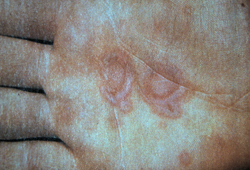Summary
Definition
History and exam
Key diagnostic factors
- presença de fatores de risco
- lesões em alvo dos membros
- episódio prévio de EM
- erosões das mucosas
Other diagnostic factors
- lesões semelhantes a alvos
- início rápido das lesões
- ciclo autolimitado
- vesículas agrupadas em uma base eritematosa
- roncos, estertores e/ou sibilos
- membranas timpânicas vermelhas
Risk factors
- episódio anterior de eritema multiforme
- infecção por vírus do herpes simples (HSV)
- determinadas outras infecções
- Infecção por Mycoplasma pneumoniae
- linfoma
- Doença de Kawasaki
- uso de determinados medicamentos
- vacinações
- tatuagens
Diagnostic tests
1st tests to order
- diagnóstico clínico
Tests to consider
- biópsia de coloração de hematoxilina e eosina
- biópsia com imunofluorescência
- Hemograma completo
- eletrólitos séricos
- sorologia para o vírus do herpes simples (HSV)
- reação em cadeia da polimerase rápida
- sorologia por hemaglutinação a frio
- títulos de M pneumoniae
- radiografia torácica
- título de autoanticorpos
Emerging tests
- anticorpos antidesmoplaquina
Treatment algorithm
eritema multiforme (EM) minor
eritema multiforme (EM) major
eritema multiforme (EM) recorrente
Contributors
Authors
Nathan W. Rojek, MD, FAAD
Assistant Professor
Director, Inpatient Dermatology
Department of Dermatology
University of California, Irvine
Irvine
CA
Disclosures
NWR declares that he has no competing interests.
Acknowledgements
Dr Nathan W. Rojek would like to gratefully acknowledge Dr Areta Kowal-Vern, Dr Jonathan Silverberg, and Dr Nanette Silverberg, the previous contributors to this topic.
Disclosures
AK-V, JS, and NS declare that they have no competing interests.
Peer reviewers
Cristine Radojicic, MD
Staff Physician
Cleveland Clinic
Cleveland
OH
Disclosures
CR declares that she has no competing interests.
Brian Swick, MD
Clinical Assistant Professor
University of Iowa College of Medicine
Iowa City
IA
Disclosures
BS declares that he has no competing interests.
Peer reviewer acknowledgements
BMJ Best Practice topics are updated on a rolling basis in line with developments in evidence and guidance. The peer reviewers listed here have reviewed the content at least once during the history of the topic.
Disclosures
Peer reviewer affiliations and disclosures pertain to the time of the review.
References
Key articles
Lerch M, Mainetti C, Terziroli Beretta-Piccoli B, Harr T. Current perspectives on erythema multiforme. Clin Rev Allergy Immunol. 2018 Feb;54(1):177-84. Abstract
Grünwald P, Mockenhaupt M, Panzer R, et al. Erythema multiforme, Stevens-Johnson syndrome/toxic epidermal necrolysis - diagnosis and treatment. J Dtsch Dermatol Ges. 2020 Jun;18(6):547-53. Abstract
Soares A, Sokumbi O. Recent updates in the treatment of erythema multiforme. Medicina (Kaunas). 2021 Sep 1;57(9):921.Full text Abstract
de Risi-Pugliese T, Sbidian E, Ingen-Housz-Oro S, et al. Interventions for erythema multiforme: a systematic review. J Eur Acad Dermatol Venereol. 2019 May;33(5):842-9. Abstract
Reference articles
A full list of sources referenced in this topic is available to users with access to all of BMJ Best Practice.

Differentials
- Urticária
- Erupção polimorfa à luz
- Lúpus eritematoso cutâneo subagudo
More DifferentialsGuidelines
- Erythema multiforme
- Diagnosis and treatment of adults with community-acquired pneumonia
More GuidelinesLog in or subscribe to access all of BMJ Best Practice
Use of this content is subject to our disclaimer